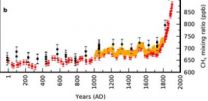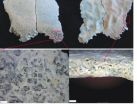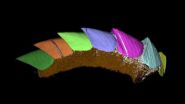(Press-News.org) Emissions of the greenhouse gas methane into the atmosphere can be traced back thousands of years in the Greenland ice sheet. Using special analytical methods, researchers from the Niels Bohr Institute, among others, have determined how much methane originates from natural sources and how much is due to human activity. The results go all the way back to Roman times and up to the present, where more than half of the emissions are now man-made. The results are published in the scientific journal, Nature.
Methane is an important greenhouse gas, which today is partly emitted from natural sources and partly from human activities. The emissions from natural sources varies due to the climate variations. For example, bacteria in wetlands release methane and less is emitted in dry periods as the wetlands shrink.
Emissions of methane into the atmosphere also come from human actions. For example, methane is emitted from rice fields, which are of course wetlands, and methane is emitted from biomass burning, either from burning of forest areas for cultivation or the use of wood in furnaces. Energy production through coal combustion also produces methane gases. But how can you determine where the methane gas comes from?
Different sources can be traced
"The different sources of methane have different isotopic compositions. The methane produced by the burning of biomass, like wood, contains more of the heavier isotope (carbon-13) relative to the lighter isotope (carbon-12), than methane which is produced in wetlands," explains Professor Thomas Blunier, Centre for Ice and Climate at the Niels Bohr Institute at the University of Copenhagen.
The researchers have measured the isotopic composition of the methane in ice cores that are drilled up from the Greenland ice cap at the NEEM project in northwestern Greenland. The ice cap is formed from snow that falls year after year and remains, gradually getting compressed into ice. The ice contains tiny air bubbles from the atmosphere in the snow that fell, and by analysing the composition of the air you can get a climate curve, which tells you about both the annual temperature and methane content.
The question is how far back in history man has had an impact on the methane concentration in the atmosphere?
Methane emissions are peaking now
"We have analysed the methane composition more than 2,000 years back in time. We can see that already 2,100 years ago during Roman times, some cultures were spreading out and burning large amounts of wood for fuel in furnaces to work with metals that required intense heat to process. But the level was still low. The next significant increase was during the Middle Ages around 1,000 years ago. It was a warm period and it was dry so there were presumably many forest fires that emitted methane while the wetlands dwindled and reduced methane emissions from that source. We also find emissions from natural forest fires and deforestation during the so-called 'Little Ice Age' (between 1350 and 1850), which was a very cold and dry period, Emissions of methane increased dramatically from around 1800, when the industrial revolution took off and where there occurred a large increase in population," explains Thomas Blunier.
The analyses show that from around the year 1800 there are large increases that are man-made. Approximately half originates from the production of food – especially rice fields and cattle. Then a lot is emitted from the decomposition of organic materials that are deposited and methane is emitted from burning coal for energy.
"The extent to which our ancestors were able to influence the emissions of methane with their activities is surprising. The general trend from 100 BCE to the year 1600 shows a correlation between the increase in the appropriation of land for cultivation and the emission of the biogenic methane. Today, half of the methane emissions stem from human activities," says Thomas Blunier.
INFORMATION:
For more information contact:
Thomas Blunier, Professor, Centre for Ice and Climate, Niels Bohr Institute, University of Copenhagen, +45 3532-0584, blunier@gfy.ku.dk
Methane emissions can be traced back to Roman times
2012-10-04
ELSE PRESS RELEASES FROM THIS DATE:
Surprising black-hole discovery changes picture of globular star clusters
2012-10-04
An unexpected discovery by astronomers using the National Science Foundation's Karl G. Jansky Very Large Array (VLA) is forcing scientists to rethink their understanding of the environment in globular star clusters, tight-knit collections containing hundreds of thousands of stars.
The astronomers used the VLA to study a globular cluster called Messier 22 (M22), a group of stars more than 10,000 light-years from Earth. They hoped to find evidence for a rare type of black hole in the cluster's center. They wanted to find what scientists call an intermediate-mass black hole, ...
50-hour whole genome sequencing provides rapid diagnosis for children with genetic disorders
2012-10-04
KANSAS CITY, Mo. – OCTOBER 3, 2012 – Today investigators at Children's Mercy Hospitals and Clinics in Kansas City reported the first use of whole genome information for diagnosing critically ill infants. As reported in Science Translational Medicine, the team describes STAT-Seq, a whole genome sequencing approach - from blood sample to returning results to a physician - in about 50 hours. Currently, testing even a single gene takes six weeks or more.
Speed of diagnosis is most critical in acute care situations, as in a neonatal intensive care unit (NICU), where medical ...
Key environmental factors influencing manta ray behavior identified
2012-10-04
Manta rays are more likely to gather together under either a new or a full moon, according to new research published Oct 3 in the open access journal PLOS ONE by Fabrice Jaine and colleagues at the University of Queensland.
The research identifies environmental factors that predict the abundance and behavior of manta rays at Lady Elliott Island in the Great Barrier Reef. The authors comment that knowing these factors is important for conservation efforts, "especially in the context of a changing climate and with targeted fisheries increasingly threatening manta ray populations ...
Oldest evidence of regular meat consumption by early humans found
2012-10-04
A fragment of a child's skull discovered at Olduvai Gorge, Tanzania shows the oldest known evidence of anemia caused by a nutritional deficiency, reports a new paper published Oct. 3 in the open access journal PLOS ONE.
The discovery, made by a global team of researchers led by Manuel Domínguez-Rodrigo from Complutense University, Madrid, suggests that early human ancestors began eating meat much earlier in history than previously believed. The skull fragment identified is thought to belong to a child somewhat younger than two and shows bone lesions that commonly result ...
Novel blood-based protein signature determined for rare, aggressive lung cancer
2012-10-04
Researchers have discovered a panel of 13 blood proteins that may be effective biomarkers to detect malignant mesothelioma, according to a study published Oct. 3 in the open access journal PLOS ONE by Rachel Ostroff from the company SomaLogic, which developed the new test, and colleagues at other institutions.
Malignant mesothelioma is a rare, aggressive form of lung cancer that can develop after prolonged exposure to asbestos. Because early diagnosis is difficult, most patients face a poor prognosis and have few options for treatment. In the study, authors compared proteins ...
Less is more when choosing between groups of assorted items
2012-10-04
When making decisions about the value of an assortment of different objects, people approximate an average overall value, which though frequently useful can lead to apparently irrational decision-making. A new study published Oct 3 in PLOS ONE by Jerald Kralik and colleagues at Dartmouth College shows for the first time that non-human primates also make similar 'irrational' choices based on approximation.
In the study, researchers found that rhesus monkeys preferred a highly-valued food item (a fruit) alone to the identical item paired with a food of positive but lower ...
Mollusc missing link revealed in 3-D
2012-10-04
Scientists have discovered a rare fossil called Kulindroplax, the missing link between two mollusc groups, which is revealed in a 3D computer model, in research published today in the journal Nature.
The researchers have unearthed the worm-like partly shelled Kulindroplax, which they have modelled in a 3D computer animation. Kulindroplax lived in the sea during the Silurian Period, approximately 425 million years ago, when most life lived in the oceans and the first plants were beginning to grow on land. The team found the Kulindroplax fossil, the only one of its kind ...
Blocking tumor-induced inflammation impacts cancer development
2012-10-04
Researchers at the University of California, San Diego School of Medicine report the discovery of microbial–dependent mechanisms through which some cancers mount an inflammatory response that fuels their development and growth.
The findings are published in the October 3, 2012 Advanced Online Edition of Nature.
The association between chronic inflammation and tumor development has long been known from the early work of German pathologist Rudolph Virchow. Harvard University pathologist Harold Dvorak later compared tumors with "wounds that never heal," noting the similarities ...
Healthcare professionals as bad as patients at good respiratory inhaler technique
2012-10-04
Healthcare professionals are as bad as patients when it comes to knowing how to use inhalers prescribed for asthma and other respiratory conditions correctly, says an editorial in Drug and Therapeutics Bulletin (DTB).
They therefore can't be relied on to teach patients how to use these devices correctly, says DTB.
But as 45 million prescriptions for respiratory inhalers were dispensed in 2011 in England alone—at a cost of £900 million to the NHS—everyone needs to be more clued up on correct inhaler technique to make sure these drugs work well for patients and offer ...
Aspirin may temper brain power decline in elderly women at risk of heart disease
2012-10-04
Daily low dose aspirin could slow the decline in brain power among elderly women at high risk of heart disease, indicates observational research published in the online journal BMJ Open.
The researchers base their findings on 681 women between the ages of 70 and 92, 601 of whom were at high risk of heart disease and stroke, defined as a 10% or greater risk on a validated risk scale (Framingham).
All the women were subjected to a battery of tests to measure their physical health and intellectual capacity, including verbal fluency and memory speed, and dementia (mini ...





